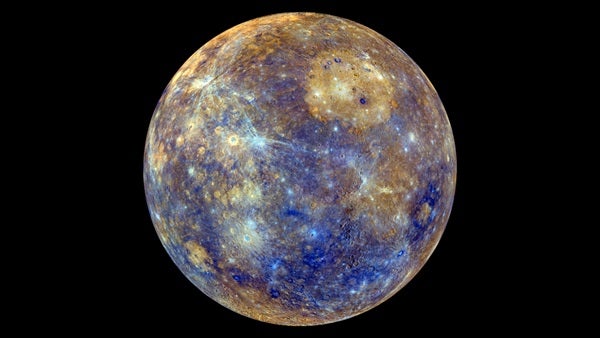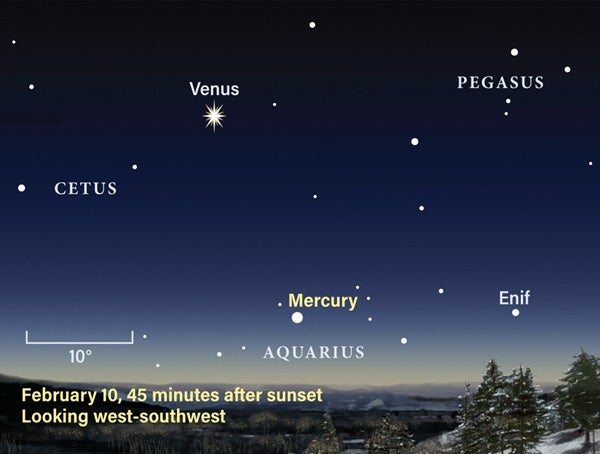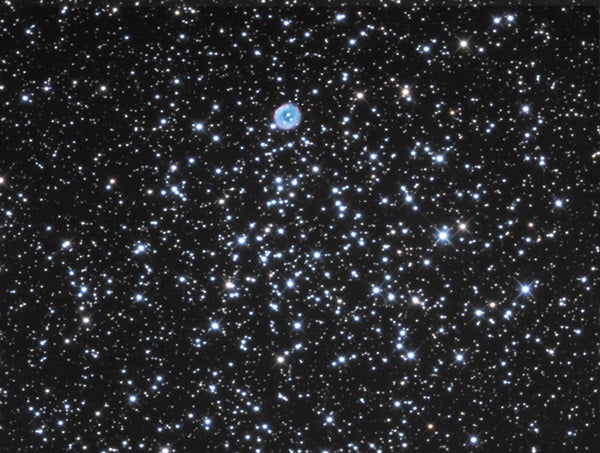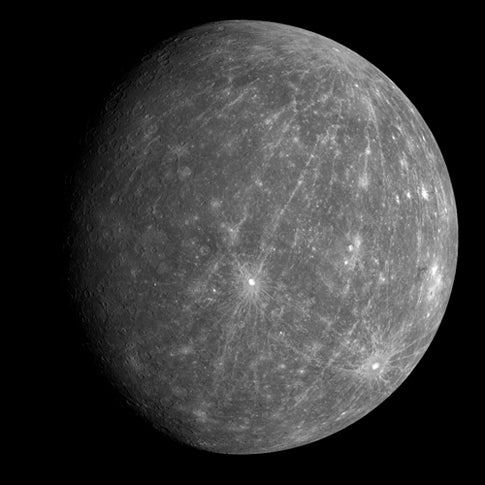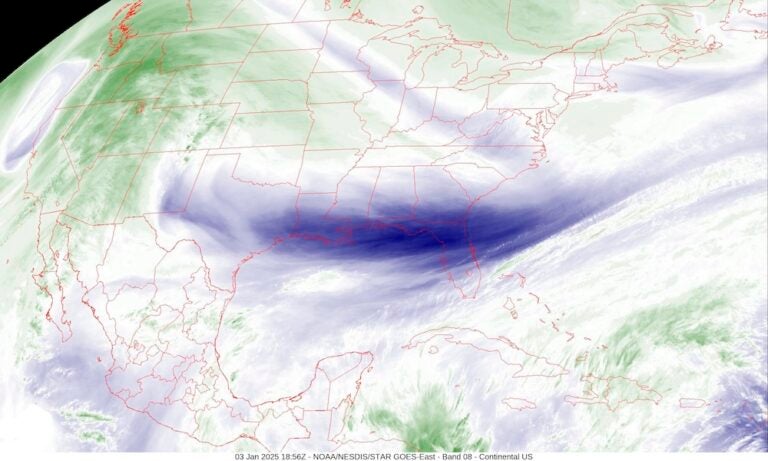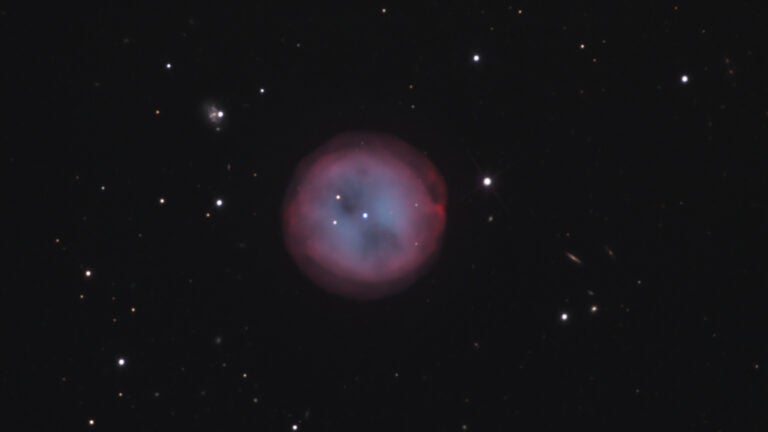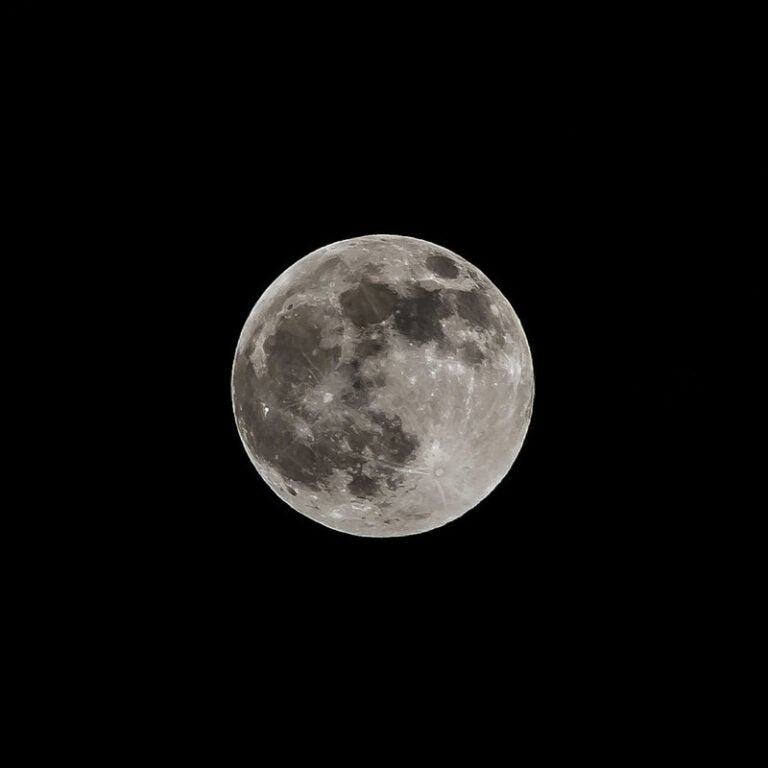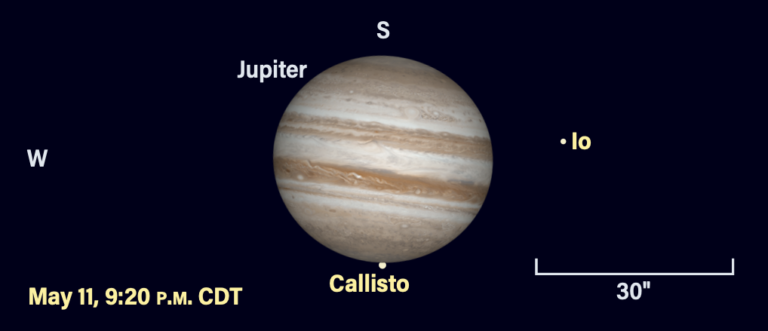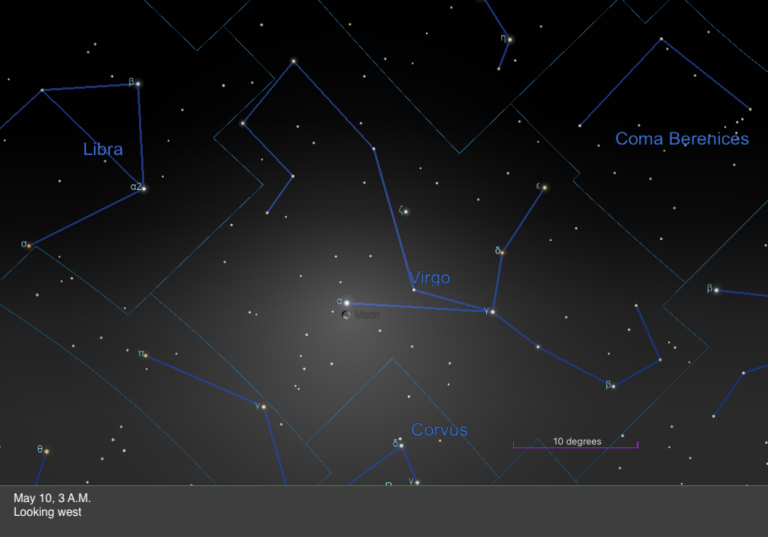This is a good week to look for Sirius in the evening sky. The night sky’s brightest star (at magnitude –1.5) appears some 20° above the southeastern horizon once darkness falls and climbs highest in the south around 9:30 p.m. local time. It then lies about one-third of the way from the horizon to the zenith as seen from mid-northern latitudes. (The farther south you live, the higher it appears.) If you point binoculars at Sirius, look for the pretty star cluster M41 in the same field of view, just 4° below the star.
Saturday, February 8
Full Moon occurs at 2:33 a.m. EST tomorrow morning (11:33 p.m. PST this evening), but our satellite looks completely illuminated all night. You can find it rising in the east around sunset and peaking high in the south just after midnight. The Moon spends the night near the border between the constellations Cancer the Crab and Leo the Lion.
Sunday, February 9
The nearly fully lit Moon appears in the company of 1st-magnitude Regulus tonight. The pair rises in the east before 7 p.m. local time and climbs high in the south around 1 a.m. Only 4° — about eight times the Moon’s apparent diameter — separate the two.
Although Jupiter passed on the far side of the Sun from Earth just six weeks ago, it has returned to view before dawn. The giant planet rises nearly two hours before the Sun and climbs 8° above the southeastern horizon an hour before sunup. Shining at magnitude –1.9, Jupiter stands out nicely against the twilight glow.
Mercury climbs to its maximum altitude in the evening sky tonight, when it lies some 11° high in the west-southwest 30 minutes after sunset. This peak coincides with the planet reaching its greatest elongation from the Sun. Mercury shines at magnitude –0.6, so it should be easy to spot in the deepening twilight. If you can’t see it with your naked eye, binoculars will show it easily. Target the planet through a telescope and you will see a 7″-diameter disk that appears half-lit.
Tonight may be your last best chance to track down Neptune during its current apparition. The outermost major planet glows at magnitude 8.0, so you’ll need to wait until darkness falls and then use binoculars or a telescope to find it. Neptune’s low altitude — it lies barely 8° above the western horizon as twilight ends — only adds to the challenge. What makes tonight so appealing for a planet quest is that the ice giant world skims just 2′ north of the 4th-magnitude star Phi (φ) Aquarii. That’s about the separation between Io and Jupiter when the innermost jovian moon reaches greatest elongation. To confirm a Neptune sighting, aim a telescope at your suspected target. Only the planet shows a 2.2″-diameter disk and subtle blue-gray color.
The Moon reaches perigee, the closest point in its orbit around Earth, at 3:28 p.m. EST. It then lies 223,980 miles (360,461 kilometers) away from us.
Tuesday, February 11
Tonight should provide your first good opportunity of 2020 to view the zodiacal light. From the Northern Hemisphere, late winter and early spring are the best times of year to observe this elusive glow after sunset. It appears slightly fainter than the Milky Way, so you’ll need a clear moonless sky and an observing site located far from the city. With the waning gibbous Moon now exiting the early evening sky, the next two weeks will be prime viewing times. Look for the cone-shaped glow, which has a broad base and points nearly straight up from the western horizon, after the last vestiges of twilight have faded away.
Wednesday, February 12
Ruddy Mars continues to grace the predawn sky this week. The Red Planet now rises before 4 a.m. local time and climbs 20° above the southeastern horizon an hour before sunrise. Mars glows at magnitude 1.3 against the backdrop of Sagittarius the Archer, having crossed the border from Ophiuchus the Serpent-bearer just yesterday. Although the passage from Ophiuchus into Sagittarius is little more than a technical milestone, it does set up a series of pretty conjunctions with some of the Archer’s deep-sky gems next week. Unfortunately, a telescope doesn’t add much to our current view of the planet, revealing a bland disk that measures just 5″ across.
Thursday, February 13
Although Saturn passed on the opposite side of the Sun from Earth only a month ago, it already appears low in the southeast before dawn. Look for the magnitude 0.6 ringed planet some 10° to the lower left of brilliant Jupiter. Saturn’s low altitude means it won’t look like much through a telescope, though that will change in the coming months.
Friday, February 14
In what seems a fitting tribute, the planet named after the Roman goddess of love shines brilliantly in the evening sky on Valentine’s Day. Venus gleams at magnitude –4.2 and shows up easily in the west-southwest within a half-hour after sunset. It grows even more prominent as darkness settles over the landscape. The planet doesn’t set until a bit after 8:30 p.m. local time. If you turn a telescope on Venus, you’ll see a disk that spans 17″ and appears about two-thirds lit.
Saturday, February 15
Last Quarter Moon occurs at 5:17 p.m. EST. Look for it either before dawn this morning (when it lies among the background stars of Libra and looks slightly more than half-lit) or after it rises around 1:30 a.m. local time tomorrow (when it stands against the backdrop of northern Scorpius and appears as a fat crescent).
A pair of fine binocular objects are on display tonight. The open star clusters M46 and M47 reside about a degree apart in the northwestern corner of the constellation Puppis the Stern. The two lie about 12° east-northeast of the sky’s brightest star, Sirius. The western cluster, M47, glows at 4th magnitude and appears as a fuzzy patch sprinkled with several pinpoint stars. Sixth-magnitude M46 shows up as a hazy collection of faint stars that is hard to resolve under most conditions. Although it contains nearly twice as many stars as M47, M46 appears fainter and fuzzier because it lies some three times farther from Earth.

